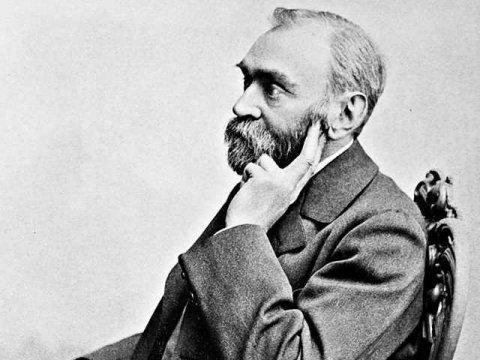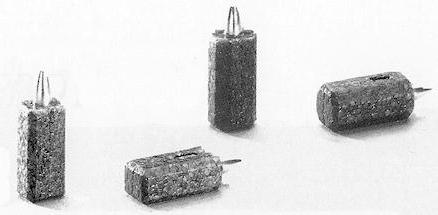Swedish chemist Nobel Alfred: biography, invention of dynamite, founder of the Nobel Prize
Nobel Alfred is an outstanding Swedish scientist, dynamite inventor, academician, experimental chemist, doctor of philosophy, academician, founder of the Nobel Prize, which has made him world famous.
Childhood
Alfred Nobel, whose biography causessincere interest of the modern generation, was born in Stockholm on October 21, 1833. He was a descendant of the peasants of the Swedish southern district of Noblef, which became the derivative of the family name known throughout the world. In the family, apart from him, there were three more sons.

The first experiments of the Swedish chemist
Having come to Russia, 9-year-old Nobel Alfred quicklymastered the Russian language, in addition to which he was fluent in English, Italian, German and French. Education boy received at home. In 1849, his father sent him on a trip to America and Europe, which lasted two years. Alfred visited Italy, Denmark, Germany, France, America, but most of the time the young man spent in Paris. There he passed a practical course in physics and chemistry in the laboratory of the famous scientist Jules Peluse, who researched oil and discovered nitriles.
Meanwhile, the affairs of Immanuel Nobel - a talentedinventor-self-taught - have adjusted: in the Russian service, he became rich and famous, especially during the Crimean War. His plant produced mines used for the defense of the Finnish fortress of Sveaborg, Kronstadt and Reval harbor in Estonia. Merits Nobel senior was encouraged by the imperial medal, which, as a rule, foreigners were not awarded.
After the war, orders stopped, the enterprise was idle, many workers were left out of work. This forced Immanuel Nobel to return to Stockholm.
The first experiments of Alfred Nobel
Alfred, who closely communicated with the famous Russianchemist Nikolai Zinin, in the meantime, closely engaged in the study of the properties of nitroglycerin. In 1863, the young man returned to Sweden, where he continued his experiments. September 3, 1864 there was a terrible tragedy: during the experiments with the explosion of 100 kilograms of nitroglycerin killed several people, among them was 20-year-old Emil - the younger brother of Alfred. After the incident, his father Alfred broke paralysis, and the last 8 years he remained confined to bed. During this period, Immanuel continued to work actively: he wrote 3 books, to which he himself made illustrations. In 1870, he was worried about the use of waste wood industry, and Nobel Sr. invented plywood, inventing a method of gluing with a pair of wooden plates.
The invention of dynamite
October 14, 1864 Swedish scientist took a patent,allowed him to engage in the production of an explosive, which contained nitroglycerin. Alfred Nobel invented dynamite in 1867; its production in the future brought the scientist the main wealth. The press of that time wrote that the Swedish chemist made his discovery accidentally: as if a bottle with nitroglycerin was broken in the process of transportation. The liquid spilled, soaked the soil, resulting in the formation of dynamite. Alfred Nobel did not recognize the above version and insisted that he was deliberately looking for a substance that, when mixed with nitroglycerin, would reduce the explosiveness. The required neutralizer was kieselguhr - a rock, called still trepel.

The laboratory for the production of dynamite Swedish chemist organized among the lake on a barge, far from populated areas.
Two months after the start of operationsa floating laboratory, Aunt Alfred brought him with a merchant from Stockholm, Johan Wilhelm Smith - the owner of a millionaire estate. Nobel managed to persuade Smith with several other investors to unite and form an enterprise for the industrial production of nitroglycerin, which began in 1865. Realizing that the Swedish patent does not protect his rights abroad, Nobel patented his own rights to manufacture nitroglycerin and its sale throughout the world.
Discoveries of Alfred Nobel
In 1876, the world learned about the new invention of the scientist- "explosive mixture", - the connection of nitroglycerin with collodion, which possessed a stronger explosive. The following years are rich in the discovery of a combination of nitroglycerin with other substances: ballistite - the first smokeless powder, then cordite.
Nobel's interests were not limited to work onlywith explosive substances: the scientist was fond of optics, electrochemistry, medicine, biology, designed safe steam boilers and automatic brakes, tried to make artificial rubber, studied nitrocellulose and artificial silk. There are about 350 patents, which were claimed by Alfred Nobel: dynamite, detonator, smokeless powder, water meter, refrigeration apparatus, barometer, combat rocket design, gas burner,
Characteristics of the scientist
Nobel Alfred was one of the most educatedpeople of their time. The scientist read a large number of books on technology, medicine, philosophy, history, fiction, giving preference to his contemporaries: Hugo, Turgenev, Balzac and Maupassant, even he tried to write. The bulk of Alfred Nobel's works (novels, plays, poems) was never published. Only the play about Beatriz Cenci - "Nemizida", which was already finished at the time of death, is preserved. This tragedy in four acts was greeted with hostility by churchmen. Therefore, all published circulation, published in 1896, after the death of Alfred Nobel was destroyed, with the exception of three copies. The world had an opportunity to get acquainted with this wonderful work in 2005; It was played in memory of the great scientist on the Stockholm stage.

Contemporaries describe Alfred Nobel asa sullen man who preferred city bustle and cheerful companies quiet solitude and constant immersion in the work. The scientist led a healthy lifestyle, negatively related to smoking, alcohol and gambling.
Being sufficiently secured, Nobel is directlygravitated towards the Spartan way of life. Working on explosive mixtures and substances, he was an opponent of violence and murders, doing tremendous work for the sake of peace on the planet.
Inventions for Peace
Initially created by a Swedish chemist, the explosivesubstances were used for peaceful purposes: for laying roads and railways, mining, building canals and tunnels (using blasting operations). For military purposes, Nobel explosives were used only in the Franco-Prussian war of 1870-1871.

Alfred Nobel: personal life
The great inventor - an attractive man -he was never married and had no children. Closed, lonely, distrustful of people, he decided to find himself an assistant secretary and posted an appropriate announcement in the newspaper. The 33-year-old Countess Berta Sofia Felicita, an educated, well-bred, multi-lingual girl, who was a homeless girl, responded. She wrote to Nobel, she received an answer from him; a correspondence began, which aroused the mutual sympathy of both sides. Soon there was an encounter between Albert and Bertha; young people walked a lot, talked, and conversations with Nobel brought great pleasure to Bertha.

Alfred Nobel and Sophie Hess
And yet in the life of Alfred Nobel was love. At the age of 43, the scientist fell in love with the 20-year-old Sophie Hess, the saleswoman of a flower shop, moved her from Vienna to Paris, rented an apartment near the house and let her spend as much as she wanted. Sophie was only interested in money. The beautiful and graceful "Madame Nobel" (as she called herself), unfortunately, was a lazy person without any education. She refused to deal with the teachers she was hired by Nobel.
The connection between the scientist and Sophie Hess lasted 15 years, until 1891year - the moment when Sophie gave birth to a child from a Hungarian officer. Alfred Nobel peacefully parted with his young friend and even appointed her a very decent content. Sophie married her daughter's father, but all the time annoyed Alfred with requests to increase the content, after his death began to insist on it, threatening in case of refusal to publish his intimate letters. The executors, who did not want the name of their principal to be rattled by the newspapers, made concessions: they bought Sophie's letters and telegrams from Nobel and increased her rent.

Since childhood, Nobel Alfred has been characterizedpoor health and constantly sick; in recent years he was tormented by heartaches. Doctors prescribed nitroglycerin to the scientist - this circumstance (a kind of irony of fate) amused Alfred, who dedicated his life to working with this substance. Alfred Nobel died on December 10, 1896 in his villa in San Remo from a cerebral hemorrhage. The grave of the great scientist is located in the Stockholm cemetery.
Alfred Nobel and his prize
Inventing dynamite Nobel saw its application inhelp the development of human progress, not murderous wars. But the recent baiting about such a dangerous discovery prompted Nobel to think that it is necessary to leave behind a different, more significant trace. So, the Swedish inventor decided to establish a personal award after his death, writing in 1895 a will, according to which the main part of the acquired state departs to a specially created fund - 31 million kroons. The income from investments should be distributed every year in the form of bonuses to people who brought the greatest benefit to humanity during the previous year. The interest is divided into 5 parts and is intended for the scientist, who made an important discovery in the field of chemistry, physics, literature, medicine and physiology, and also made a significant contribution to the maintenance of peace on the planet.
A special wish of Alfred Nobel was the failure to take into account the nationality of the candidates.

The first award of the Alfred Nobel Prizetook place in 1901: it was received by the physicist Roentgen Conrad for the discovery of the rays bearing his name. The Nobel Prizes, which are the most authoritative and honorable international awards, had a huge impact on the development of world science and literature.
Also in the history of science Alfred Nobel, willwhich struck many scientists with his generosity, came in as the pioneer of the "Nobel" - a chemical element named in his honor. The name of the outstanding scientist is the Stockholm Institute of Physics and Technology and Dnepropetrovsk University.







